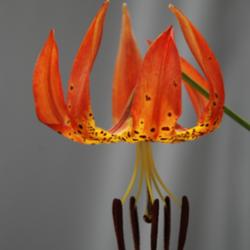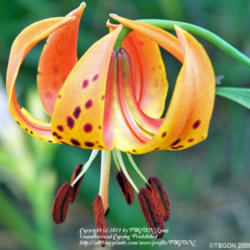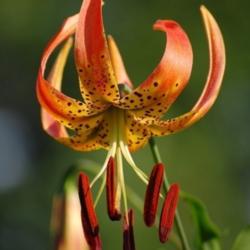They are the ancestors of all the lovely hybrids that we enjoy in our gardens today, those wild lilies that grow freely in different parts of the world. They have different faces, different names in other places, but I was the lucky one. The beautiful Turk's Cap Lily grew wild and wonderful in the Southern Appalachian mountains of Southeast Kentucky where I grew up.
Before I take you on another storytelling venture, I should mention that there are other lilies that wear the same common name. Quite often the lovely purply-red Lilium martagon is known as Turk's Cap too, but I'm going to tell you the story of Lilium superbum, whose blooms are more orange than purple. The color might be the only difference in the two, but I'm truly only on a first-name basis with the one that blooms a fiery orange, Turk's Cap Lilium superbum.
I was always an avid reader. I climbed the mountain behind my house all summer long, sometimes with a book tucked into a pocket, but during winter when the mountain was too snow covered to climb, I read everything I could get my hands on. There was a bookshelf at the top of the stairs, very near my second floor bedroom. On rainy days and all through winter for many, many years, I read every book on those shelves. I was probably too young to read some of them, but I didn't understand them anyway, so no harm done. That was upstairs; when I was downstairs there was always a copy of Grit, much like a newspaper, or Look and Life magazines, both of which had wonderful pictures. My world was filled to the brim with mountains, plants, words, facts, fantasies and fairy tales. I loved it all.
There was an illustrated book of fairy tales on one of the upstairs shelves and I dearly loved fairy tales. They took me to faraway places all winter long, places with beautiful kingdoms, happy princesses, magic lamps, talking plants and carpets that would fly. It should not be surprising that even now I talk to my flowers and sometimes I hear them talking back, but doesn't everybody? I was also interested in the illustrations and often copied my favorites. Then I would color them with crayons or colored pencils and make up stories of my own. One of my favorite fairy tales was about Aladdin. Pure magic.


Of course these images are not my drawings, they're from Wikimedia Creative Commons, but I'm sharing them with you because they are similar to those I remember from the book of fairy tales. Look closely at the turbans in the drawings, look very closely. Now take another look at the two images of Turk's Cap Lilies above. See the similarities? That's where the common name came from. Obviously, you already knew that, but seeing the pictures takes us straight into the heart of my story.
When I was about 9 or 10, I was allowed to wander our mountain quite freely, as long as I stayed near the stream that ran from the top of the mountain down beside my house and on to faraway places. I always took my dog Pepper with me just in case I happened upon a monster or two. She knew the mountain paths better than I did, so she was a great traveling companion. One warm July day she led me to a clearing, not very big but very near the mountain stream and very high upon the mountain. The clearing was filled with tall stems that were covered in oddly shaped orange flowers. In all my experience with flowers, I'd never seen one whose face turned downward. Most often they looked up at the sun. Some of them were taller than I was, so I could look at those flowers almost nose to nose, and they were incredibly beautiful to me, maybe because they were all so unusual, like children who were too shy to meet your eyes. The blooms were also larger than most wildflowers that grew in our mountains.
I picked one or two of the blooms, leaving most of the bloom stem behind because there were lots of blooms left on it and Aunt Bett always told me that a bloom or two was more than enough to take from a family of plants. I hurried down the mountain with a bloom in each hand. I had to show Aunt Bett what I'd found. I'd gone farther up the mountain than I realized because I was breathless when I passed Mom in our back yard and barely said the words loud enough to be heard: "Gonna see Aunt Bett, Mom. Be right back!" I didn't wait for an answer. My flying feet flew down that dusty little one-lane road, so excited because I'd discovered a new flower.
"Look at this, Aunt Bett, woodja jus' look at this!" The words stumbled all over each other, but she looked closely.
For a minute or two she didn't say a word and I thought I might have brought her something poisonous, I wasn't supposed to touch plants I didn't know, so I interrupted her silence. I could always talk my way out of any kind of trouble by slightly changing the subject.
"Aunt Bett, looks jus' like th' hats in the 'laddin story in the book upstairs, you know, those wrapped around hats; I drew those pictures, remember?"
To my surprise, Aunt Bett looked at me with a smile on her face.
"Them's Turk's Cap Lilies, Chile, I've been lookin' for them for years. Now where'd ya find 'em? Their bulbs is awful good to eat!"
And that was my introduction to one of the prettiest native wildflowers I'd ever seen, the Turk's Cap Lily,
Lilium superbum, and Aunt Bett loved it too.
The tall flowering stem of the Turk's Cap Lily bears several drooping orange flowers. Sometimes they are a true orange, but often they wear a reddish tint or even a hint of golden yellow. They are heavily spotted, and the spots are a brownish-maroon color. They have recurved petals and petal-like sepals that truly resemble the type of head gear worn by the early Turks. There is a surprising streak of green that forms a star across the base of each flower segment. Of course you have to be lying on your back looking up to see it, but at 9 or 10 that was easily accomplished. I might never get back up again if I tried it at this age.
It's native to the United States and it loves the mountain forests of Southeast Kentucky about as much as I do. It blooms in July, August, and September and must be located where the bulbs are shaded and the blooms receive sunlight. That's accomplished by low-growing plants as companions, like trillium and mayapple, and quite often there's enough debris on the forest floor to protect the bulbs as well. It grows best in moist, slightly acidic soil that's well drained.
It's one of our most impressive native lilies simply because of its size; it's the largest lily growing east of the Rocky Mountains. Those that grow in the North seem to have a dark purple tint in their coloring, but it's the same plant if it has the green streak that forms a star. The bloom stems can grow to 4 to 6 feet in height and the nodding blooms are 2 to 4 inches wide. The petals recurve so much they touch at the stem, which definitely looks like a Turk's cap.
Aunt Bett always told me that it shouldn't be moved and that I should never think of trying to transplant it from the mountain down into my back yard, no matter how pretty it was. She said it was one of those plants that was best left where it was growing. I have to admit that I tried. Oh boy, did I try. But she was right. They didn't like living where I could easily see them. I hate to even think of how many I probably killed with all my attempts. I learned better by doing, though, no matter that the doing was a complete failure.
The blooms are also favorites of hummingbirds, moths, long tongued bees, and swallowtail and monarch butterflies; that's how they are pollinated. Beautiful flowers and beautiful pollinators!
There was a time, Aunt Bett said, when it was thought that a tonic made from the leaves and roots was good for the heart, but she also said she'd never tried it because it was one of those "old fashioned" remedies and some were too old to be believed. She did believe in using the bulbs as food, and one warm fall day Pepper and I climbed that mountain again, just to dig a few bulbs for her. She added them to her soup that evening and invited me to supper so I could try them too. As I remember, they tasted a lot like potatoes, but I told Aunt Bett that it was the best soup I ever did eat. She was right proud that I loved her lily soup.
I think they would grow well and be beautiful with ferns of most any kind as understory plants. If it weren't so hot and dry here in Western Kentucky, I would try them together. Of course, cultivated bulbs are available and I could plant them, but Turk's Cap Lilies are true lilies and they don't need cultivation to be beautiful. They have a beauty all their own, a fairy tale kind of beauty, but only if they grow under perfect conditions.
Maybe you thought I was rambling around in mindless chatter again. It's true that I often talk about unrelated things within the same sentence. After all, Aladdin and Turk's Cap Lilies have very little in common, but such is the way of learning when you spend your childhood years roaming around in the mountains. The truth is, I am forever thankful for every lesson those mountains taught me, and the Turk's Cap Lily growing in its natural habitat was a truly beautiful lesson.







